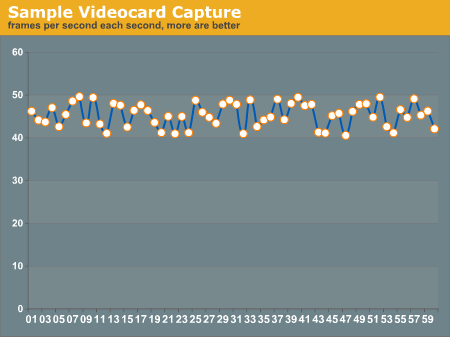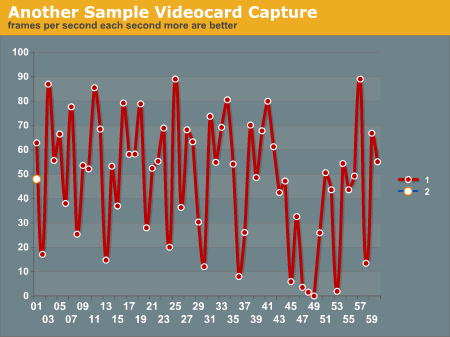Building a Better (Linux) GPU Benchmark
by Kristopher Kubicki on September 24, 2004 12:05 AM EST- Posted in
- Linux
Why Average Frames Per Second Can Be Misleading
Timedemos make up the core backbone of our video card benchmarks. Timedemos are simply pre-recorded scenes that are re-rendered as the program plays them back. The example that we use here is the timedemo "radar" from the game Wolfenstien: Enemy Territory. Depending on the conditions of the testbed, radar might render more or less frames than another machine, but both machines will always take the same amount of time to play back. The program generally reports the number of frames rendered and we divide by the number of seconds that the timedemo lasted. This calculates our average frames per second.Plotting more than just the average FPS is not a new concept. AMD, Intel, NVIDIA and ATI have all expressed their thoughts to us about plotting box-and-whisker or line graphs of our timedemos rather than just an average FPS. Of course, CPU manufacturers do not like timedemos at all, but that is an argument that we will leave for a different day. Let us claim during our timedemo that we record the instantaneous frames per second several times. "Instantaneous" may be a bit of a misnomer if you do not have an explicit math background, but for argument's sake, let's say that we are calculating how many frames we render in exactly one second and plotting those FPS over the course of a minute. The graph may look something like this.

This line graph demonstrates a 60-second clip from a timedemo with 45 average frames per second. When we look at an average FPS, we expect the timedemo's instantaneous frames per second to look something like this. In reality, the timedemo may look something more like this extreme example below.

Both graphs have an average ~45 frames per second. In fact, the lower graph actually averages to slightly higher. We make written notes of issues like this in our Windows GPU analyses, but a line graph puts it into a format that is less subjective.










23 Comments
View All Comments
yelo333 - Friday, September 24, 2004 - link
#12, as they mentioned in the article, that was with FRAPS...FRAPS does not run on linux, and, IIRC, can give invalid results sometimes. The point of this tool was gpu benchmarking for linux. Only as a side note did they say they might port it to windows.AlphaFox - Friday, September 24, 2004 - link
I recall seeing these graphs in past reviews, is this really new?yelo333 - Friday, September 24, 2004 - link
Very nice work...nice to see some linux stuff going on here ;)Maybe this will invigorate ATI to make better drivers for linux...Image IQ + speed of drivers are terrible - In my informal tests on a radeon 9000np, the linux drivers have about 1/4 the image IQ/speed of the windows versions...
Jalf - Friday, September 24, 2004 - link
Wow, great work... :)So, now you just need to port it to Windows as well... ;)
bdykes - Friday, September 24, 2004 - link
Nice article! Is there any chance of making the benchmark tool available for download? :)bdykes - Friday, September 24, 2004 - link
mercador - Friday, September 24, 2004 - link
Anyone knows when it will be the next PC round up?mercador - Friday, September 24, 2004 - link
Really good work, hope to see the mext round up, very anxious to choose a gfx card using your methodKeep the good work
sprockkets - Friday, September 24, 2004 - link
Perhaps people need to know where OpenGL came from, hint, perhaps OPEN can help you with that. And then figure out that Linux can run OpenGL games just fine.appu - Friday, September 24, 2004 - link
You guys are fantastic! Carry on the good work, and yes, I'm really looking forward to the final roundup.